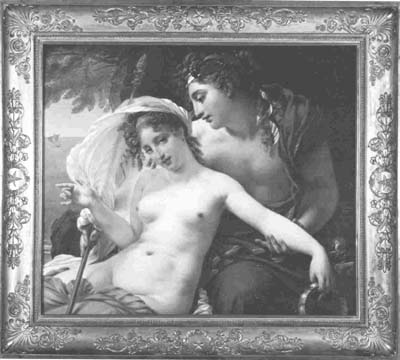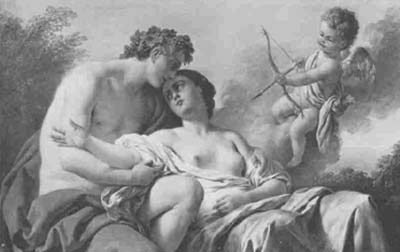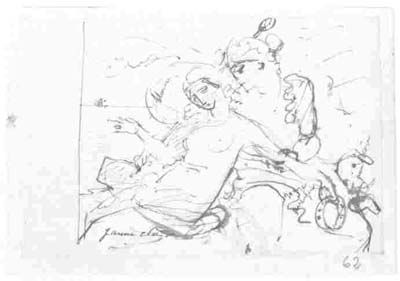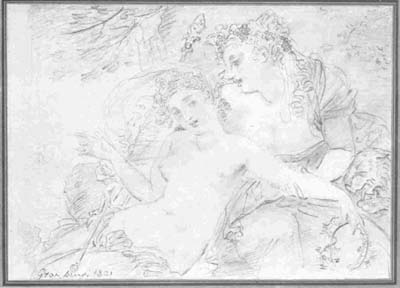
Annual Bulletin 2, 1978-1979
Home
Français
Introduction
History
Annual Index
Author &
Subject
Credits
Contact




Bacchus and Ariadne, by
Antoine-Jean Gros
by Thomas W. Gaehtgens
Pages 1
| 2 | 3
| 4
| 5
| 6
This painting, which depicts the figures in approximately life size, is
painted in clear, brillant colours. Only the pink colour used for Ariadne's
body stuck Gros's contemporaries are too gaudy. Her body is modelled with
great care. The sunshine coming from the left bathes her body in bright
light while the translucent veil causes a slight shadow on her shadow on her
face and right shoulder. The depiction of her naked body brings out quite
clearly the sensuality with which her new lover turns toward her. Bacchus
appears to be bursting with strength, but the slender fingers which which he
clasps his lover's arm contrast somewhat with his own powerful arm, which is
highly foreshortened in this painting. The God of Wine is clothed in a red
cape which, together with the white of the veil and the bright yellow of
Ariadne's garment, form a harmonious triad of colours. The clear unbroken
colours envelops the two figures as they lean toward each other. The
arrangement of the figures, the sequence of motion and the choice of colour
thus all combine to emphasize the subject of the picture. The various
attributes that characterize the figures, namely the vessel in the distance,
the thyrsus, the panther and the crown of stars on the right-hand side, have
been placed at the edges of the painting (the stars are repeated in the
frame). The sensuality in the representation of the bodies is an essential
aspect of the picture, and it would seem that Gros wished to give it a
double dimension. On the one hand it explains the tenderness with which
Bacchus turns to Ariadne in the story depicted by the painting, and on the
other hand it introduces an erotic element for the viewer, whose eye Ariadne
seems to be trying to catch.
A detailed analysis of the painting Bacchus and Ariadne thus
reveals a complex and subtle structure. Few of Gros's contemporaries were
able to understand and appreciate his attempt to capture the "fertile moment"
of this mythological love scene. Furthermore, a study of the traditional
artistic treatment of this subject shows that Gros has introduced a
psychological dimension into his version of the love story which is lacking
in paintings from earlier centuries.
Unfortunately we do not know whether Count Schoenborn specified the
subject himself or - as is more likely - merely commissioned a history
painting of a mythological subject from Gros. Whatever the case, Gros was
able to fall back on a long iconographic tradition when planning the
conception of his painting. The story of Bacchus and Ariadne is a love theme
which has frequently been painted since the Renaissance and artists have
treated it in a variety of ways. (7) Gros did not choose Araidne's first
encounter with Bacchus, which was painted by Titian for the "camerini
d'alabastro" of Duke Alphonse I of Ferrara. (8) In Titian's work, Bacchus is
jumping from his chariot to greet Ariadne. (9) Nor did Gros imitate the type of
painting widespread in the Baroque ear in which Venus leads Bacchus to the
grieving Araidne - a scene which Guido Reni (1575-1642) captured in two
paintings. (10)
Instead, Gros opted for the love scene and thus for what was probably the
most common type of painting in France. Charles-Joseph Natoire, for example,
painted the lovers in a landscape setting for a Salon at the Chateau de
Marly (fig. 2).(11) The painting, which was exhibited at the 1743 Salon,
depicts both figures sitting peacefully side by side. They are shown
full-length and Ariadne has placed her left arm around Bacchus's shoulders.
Their faces are turned toward each other. As in Gros's work, Ariadne is
holding the crown in her hand.
The painting done by Louis Jean François Lagrenée (the elder) (fig. 3),
which was exhibited at the 1769 Salon, is in the same iconographic tradition.
However, in this painting the scene is much more concentrated in its effect
than in Natoire's; (12) to a large extent, Lagrenée dispensed with the
accessories that Natoire used to create an Arcadian landscape. But, if one
ignores the figure of Cupid, Lagrenée, without decisively altering the
iconographic tradition of the theme painted by Natoire (who was still
influenced by the rococo) managed to give the subject more concentrated form.
In the same generation, Joseph-Marie Vien (1716-1809), a contemporary of
Lagrenée, also helped to propagate the new classical forms.
Nevertheless, it is instructive to read that Diderot was not particularly
favourable in his judgement of the paintings exhibited by Lagrenée at the
1769 Salon: "There is no life expression," is his general criticism. He
devotes only a few lines to Bacchus and Ariadne, but they contain an
important observation:
But look at Ariadne's left arm. See how stiff it is. Her face is dark and colourless. Bacchus looks like a Saint John. And what is Cupid doing there? You would think that the artist was unable to put any love into his characters so he put it beside them...." (13)This last comment, which is very apt, seems to point the way already to new methods of representing the subject. In his treatment of the theme, Gros went one step further than his eighteenth-century predecesors. In his painting, the scene is monumentalized by the half-length presentation of the life-size figures, and the viewer is more directly confronted by it. Instead of depicting a love scene in an Arcadian setting, Gros attempts to bring out in the composition of the painting the psychological aspects of Ariadne's change of lovers.
Unfortunately, no studies have been preserved which could perhaps have thrown some light on the evolution of the painting. Two extant drawings, both in the National Gallery of Canada, show the composition in its final form. One of the studies is a quickly executed pen-and-ink drawing (fig. 4) in which the artist has indicated the colours he intends to use, (14) and the other is a large pencil sketch which is signed and dated: Gros Brux. 1821 (fig. 5). The obvious conclusion is that Gros did the sketch while visiting his master in Brussels in 1821, to show him the intended composition of the painting. He left the sketch with David, as is proved by the fact that it later turned up in the collection of his grandson, J. L. David. (15)
The auction catalogue, prepared for the public sale of Gros' estate, mentions two further studies for Bacchus and Ariadne: one of them, in "charcoal and white chalk on a printed cloth," (16) was acquired by J. B. Delestre for 32.50 francs; the other, "in black chalk," (17) was purchased by M. Delaverne for 29 francs. These two traditional sketches might show the different steps by which Gros arrived at his design, if they could be found.
Next Page | artistic inspiration for the work
1 | 2 | 3 | 4 | 5 | 6
Annual Index | Author & Subject | Credits | Contact
This digital collection
was produced under contract to Canada's Digital Collections program,
Industry Canada.
"Digital
Collections Program, Copyright
© National Gallery of
Canada 2001"